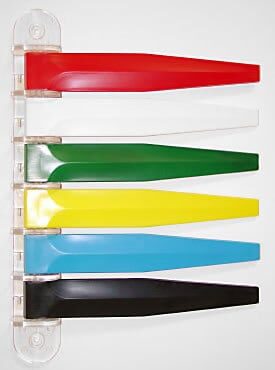On Monday, I blogged about the latest example of Toyota helping hospitals improve (by helping them learn about better ways to get better):
Toyota Helps Another Dallas-Area Hospital: The Parkland Emergency Department
Toyota helped Parkland reduce waiting times for patient discharges by, among other things, making improvements to their lights and software that gave visual signals about patient and room status. As I mentioned, many clinics and hospitals have addressed that problem with analog “flags” like this:

It goes to show there are often different countermeasures for addressing the same problem. Parkland built a new facility and went with what would be viewed as a “modern” approach with lights and technology. But, that technology has to serve the people and the process… the integration of workflows and technology is what matters.
I saw this recent article from Malaysia:
LEAN Healthcare: Reducing patient waiting times, one small step at a time
They put Lean in all caps… it's not an acronym.
Anyway, back to the article. Their ministry of health is trying to reduce the typical department length of stay number from five hours to something shorter. And Lean is something they're using to help:
The length of waiting times in the ER can prove to be taxing on patients and linked to inefficiencies in health care and dissatisfaction among both patients and caregivers.
One doctor, Dr. Nor Akma bt Yusuf, Deputy Director of the Hospital Management Services unit in the Ministry of Health, set out to change this by reducing the waiting times for patients in public hospitals.
When Dr. Nor Akma proposed her transformation project – called the LEAN healthcare – , she faced scepticism and doubt. The LEAN healthcare began with a pilot project carried out at Hospital Sultan Ismail in Johor Bahru to demonstrate its ‘proof of concept'.
It's not at all uncommon for people in healthcare to be skeptical about Lean. It's natural to feel that way. But, instead of telling people to not be skeptical or not be resistant, we should talk to them… listen… work with them.
Demonstrating a proof of concept, a pilot, a small test of change — that can be a great way to get started and help people see (and work toward) the benefits we'd expect to get from Lean, given some experience with this approach.
From the article:
…the unavailability of beds has posed a serious problem, causing large numbers of patients to have to wait for a bed and consequently prolonging the overall waiting times. The fault lies in the inefficient discharge process in emergency departments.
“That is the issue of all our busy hospitals,” she says. Patients have to wait up to six to seven hours for a bed and “it's so uncomfortable”.
That sounds like a similar cause (if not a “root cause”) as they saw at Parkland. I've seen other hospitals where the main bottleneck is not the E.D. discharge process, but rather it's the lack of availability of inpatient beds for those who need to be admitted… that can clog up the E.D. flow in a different way and requires different countermeasures.
To address this problem, the team worked with the hospital staff to come up with cost-effective and simple solutions to make the management better. Hospitals without efficient technology were asked to improvise using traffic light coloured magnets to coordinate bed allocations.
Beds that were ready to be filled had green magnets; those that were filled with patients in care had red magnets and those with patients that were soon to be discharged, had yellow magnets.
“All that gives you a visual” edge, she says and it's a “very fast” way for nurses to allocate bedding in wards.
To me, Lean isn't about throwing technology at a problem. There's a time and a place for technology… but Lean thinking generally encourages us to find simple and inexpensive solutions (or “countermeasures”).
The hospital in Malaysia found a different way to use visual management to improve their process.
As we saw with Parkland, there were also different causes of delay and different countermeasures (or improvements) that were put in place.
What Were the Results?
Results from their various Lean efforts include:
- Oncology “waiting time for patients diagnosed with head and neck cancer to receive radiotherapy was reduced from four months to one month”
- Orthopedic clinic “waiting time was almost halved from 115 minutes to 62 minutes”
These results (notice the Toyota-like emphasis on FLOW instead of cost cutting?) lead to the push to use Lean in the E.D.
Optimising patient flow through the initiatives of the LEAN project has since become the main focus from 2014. Ever since then, it was found that both patients and medical staff benefitted from the project. Patients had a reduced waiting time and work also became more efficient for the medical staff, making them happier.
Lean is supposed to be win/win/win – better for the patients, staff, and the healthcare organization.
Many of the hospitals are reducing their reliance on outside consultants to build in-house teams of internal consultants.
Best wishes to the hospitals in Malaysia!! I hope they expand their focus to also focus on patient safety and other aspects of quality beyond reduced waiting times. Keep everybody happy and help them get happier…
Please scroll down (or click) to post a comment. Connect with me on LinkedIn.
Let’s work together to build a culture of continuous improvement and psychological safety. If you're a leader looking to create lasting change—not just projects—I help organizations:
- Engage people at all levels in sustainable improvement
- Shift from fear of mistakes to learning from them
- Apply Lean thinking in practical, people-centered ways
Interested in coaching or a keynote talk? Let’s start a conversation.










Thank you for the sharing, it is great article and useful reference for people who have various cares..care of patients, care of peers, care of their organization and of care of process fine-tune.